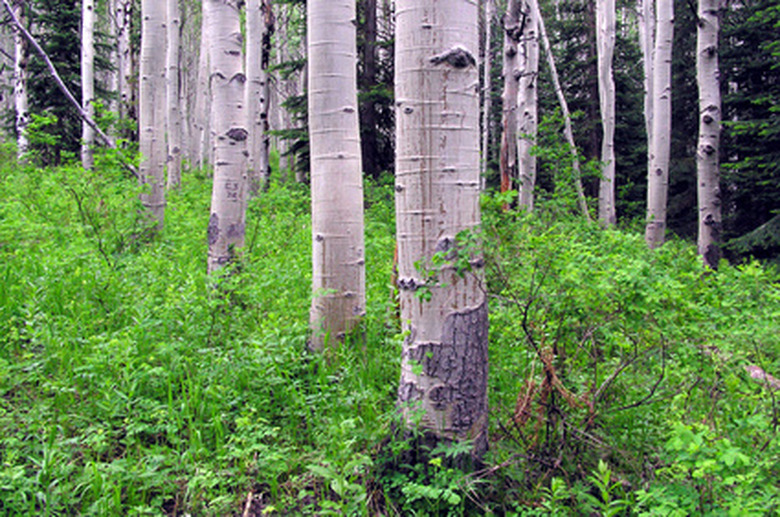Diseases Of The Quaking Aspen Tree
The quaking aspen tree (Populus tremuloides), also known as the trembling aspen, grows in most of North America. Quaking aspen trees grow up to 60 feet tall and 30 feet wide. The wood from the aspen is used mostly to make paper products. During the winter, deer eat the bark for food and birds eat the buds.
Hypoxylon Canker
Hypoxyon canker is one of the largest killers of quaking aspen trees in North America. Symptoms of this disease include: yellow-orange indented areas on the trunk of the tree; dead branches; irregular bumpy edges around the diseased area; and invasion by insects.
The aspen's bark becomes dappled as the disease progresses and acidic-scented sap flows from the wounded area. Blisters appear under the dead bark after two years of disease. The bark bursts open and underneath are small bristles called hyphal pegs.
- The quaking aspen tree (Populus tremuloides), also known as the trembling aspen, grows in most of North America.
- Hypoxyon canker is one of the largest killers of quaking aspen trees in North America.
The hyphal pegs produce spores which then crumble. After the spores disintegrate, the inner bark becomes shiny with black and yellow speckles. Cankers appear after two to three years from the onset of the disease. Black, crusty, toxic fungus forms cankers that invade the healthy bark of the tree, cracking it along the edges of the canker. The dead bark drops off the tree, leaving a checkered pattern behind. Cankers can be up to 3 feet wide. After suffering for years with the disease, the cankers surround the tree, killing it. The weakened state of the diseased aspen also causes it to be susceptible to wind damage before the cankers actually destroy the tree.
- The hyphal pegs produce spores which then crumble.
- Black, crusty, toxic fungus forms cankers that invade the healthy bark of the tree, cracking it along the edges of the canker.
Cytospora Canker
Cytospora canker, a fungal disease, affects quaking aspen trees as well as spruce, cherry, birch, cottonwood and poplars. The disease causes cankers to form on the trunks and branches of the tree. The Cystospora canker disease is easily recognizable on quaking aspen trees because the orange cankers stand out against the light bark.
Cytospora symptoms in aspen trees appear as bark that has orange spots and shades of yellow, orange and black on the branches and on the tree trunk. A sticky liquid also flows from the cankers. The cankers appear as indented, black areas on the dead bark. The cankers also exhibit black pimples that reproduce more fungi. Dampness causes the pimples to produce huge amounts of spores that seep from the pimples in long, orange threads.
- Cytospora canker, a fungal disease, affects quaking aspen trees as well as spruce, cherry, birch, cottonwood and poplars.
- Cytospora symptoms in aspen trees appear as bark that has orange spots and shades of yellow, orange and black on the branches and on the tree trunk.
The cankers weaken the resistance of the aspen trees, making them prime hosts for insect infestation. The disease eventually kills the tree.
Heartrot
Heartrot is caused by the fungus Phellinus tremulae. The disease spreads quickly, especially if the quaking aspen tree is already under stress from drought, insects or root damage. Heartrot prevents the tree from eliminating waste by causing decay in the heartwood of the tree where waste is deposited. When the heartwood becomes diseased, the tree cannot move waste products and eventually dies. The aspens become so weakened by heartrot that they are easily knocked down by strong wind.
- The cankers weaken the resistance of the aspen trees, making them prime hosts for insect infestation.
- The aspens become so weakened by heartrot that they are easily knocked down by strong wind.
